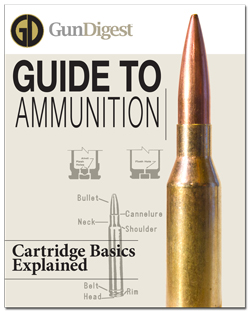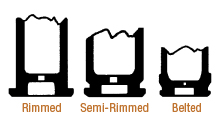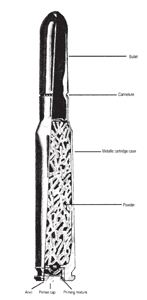Learn cartridge identification for handgun ammunition and rifle ammo. From the ever-popular .22 ammunition, to handgun ammo of all types, this download will teach you the basics of how to identify the right kind of ammunition for your gun and application. Includes a special section on shotgun shells, so you can learn how to identify 12 gauge and 20 gauge shotgun shells, and 410 shotgun shells. You’ll learn about:
• Shotgun Ammunition
• Rifle Ammunition
• Handgun Ammunition
• Cartridge Identification
• And more!
Get Your FREE Ammo Primer Download Today!
To receive your free download, join our mailing list and never miss news, tips, promotions or discounts.

Here’s a Sneak Peek Inside Your Free Guide to Ammunition:


The cartridge base and rim type are important identifying features. These also serve an important functional purpose in feeding and extraction of the cartridge within the gun mechanism. There are five rim types: rimmed, semi-rimmed, rimless, belted and rebated.
Rimmed cartridges have a rim or extractor flange of larger diameter than the case base, often with a grooved or undercut area immediately ahead of the rim. Semi-rimmed cartridges have a rim that is only slightly larger in diameter than the base, and usually also a distinct undercut area between the rim and case base. It is rimmed cartridge without actually measuring rim and base diameter, and these can easily be mistaken for a rimless case. Rimless cartridges have a rim and base of the same diameter although the rim may actually be .001- or .002-inch larger than the base.
These are the most common type of military cartridges. Belted cartridges have a distinct belt or flange at the base, just forward of the rim, and an extractor groove between the rim and the belt. Rebated cartridges have a rim of significantly smaller diameter than the case body at the base, plus a definite extractor groove between rim and base or belt. Only a few rebated cartridges have been commercialized with success, and those are usually easy to identify.
In several rebated rim designs, the rim is only very slightly smaller than the case head. The .404 Jeffery and its derivatives (chiefly the Imperial and Canadian Magnums) are the best examples.
These can be difficult to identify without taking careful measurements. Also, note that naming a case design “semi-rimmed” versus “rimmed” is strictly a subjective call—there is no specified difference in base diameter and rim diameter that automatically separates these two styles. However, cases described as semi-rimmed are usually visually distinguishable from similar rimless cases.
Snag Your FREE Download Filled with Ammunition and Reloding Advice Today!
Join the Gun Digest newsletter and become an ammunition expert!
